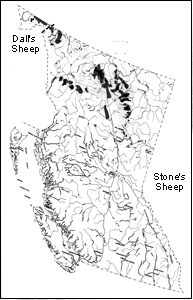Subspecies: Dall's Sheep (Ovis dalli dalli)
Subspecies Description:
Dall’s Sheep is characterized by its overall white or creamy white coat and tail. This all-white pelage distinguishes them from Stone’s Sheep with its grey to black body, white rump patch and black tail. But some populations (mainly in the Yukon) have intermediate forms between Dall’s and Stone’s Sheep. Some individuals may be all white with only a black tail, others can show light grey patches, often on the middle of the back.
Measurements:
total length: male: 1,552 mm (1,346-1,740) n = 11; female: 1,372 mm, n = 1
tail vertebrae: male: 94 mm (70-121) n = 9; female: 85 mm (70-90) n = 10
hind foot: male: 402 mm (370-432) n = 10; female: 338 mm (350-390) n = 10
ear: male: 89 mm (85-92) n = 6; female: 87 mm (80-90) n = 9
shoulder: male: 988 mm (927-1090) n = 9
chest: male: 1,159 mm (1,100-1,240) n = 5; female: 1,085 mm (1,050-1,120) n = 2
weight: male: 84.1 kg (70-103) n = 5; female: 48.8 kg (46-51) n = 8
skull length: male: 249.0 mm (235-256) n = 16; female: 228.0 mm (220-238) n = 4
skull width: male: 122 mm (108-116) n = 7; female: 115 mm (112-117) n = 3
Range:
In British Columbia, Dall’s Sheep is restricted to the southern extension of the St Elias Range in the Haines Triangle west of Bennett Lake in the extreme northwestern portion of the province. Outside B.C., the subspecies inhabits the Mackenzie Mountains along the border between the Yukon and the Northwest Territories, and various mountain ranges in the Yukon and Alaska.
It is not easy to see Dall’s Sheep in the province, and visitors prepared to travel to the extreme northwestern part of B.C. may have better luck going a little further into the Yukon and visiting Sheep Mountain in southern Kluane National Park Reserve, southwest of Haines Junction.
Conservation
The 500 Dall's Sheep estimated in British Columbia in 1977 represent only a fraction of the total world population of around 100,000. Because of their low numbers in B.C., Dall's Sheep is included on the province's blue list of species at risk.
Subspecies: Stone's Sheep (Ovis dalli stonei)
Species Description
Stone’s Sheep varies in coat colour from light grey to a grizzled grey-brown to almost black. This subspecies of Thinhorn Sheep tends to be darker in the southern and eastern parts of its distribution, and lighter in the north and northwest. But a single population may contain almost the entire range of coat variation, although one colour type generally predominates. The colour of the neck and face also varies from light grey to darker grey in the dark-colour forms. Stone’s Sheep also has white inside the ears and grey on the outside, a white belly, white on the backs of the legs, and a large white rump patch with a black tail. The dark tail stripe extending forward from the tail may or may not be continuous across the rump patch, and older males may have a dark band running across the underbelly. The horns of both sexes are similar to those of Dall’s Sheep.
Measurements:
total length: male: 1,595 mm (1,321-1,803) n = 5; female: 1,308 mm (1,295-1,321) n = 2
tail vertebrae: male: 102 mm (76-114) n = 5; female: 89 mm (76-102) n = 2
hind foot: male: 433 mm (419-457) n = 5; female: 380 mm (350-400) n = 16
ear: male: 95 mm n = 1
shoulder: male: 1,106 mm n = 1; female: 883 mm (700-950) n = 16
weight: male: 88.6 kg (77-100) n = 2; female: 51.3 kg (45-61) n = 7
skull length: male: 253.3 mm (250-257) n = 5
skull width: male: 118.8 mm (117-121) n = 5
Range:
Stone’s Sheep distribution in northern B.C. runs northwest to southeast from the east side of Bennett Lake on the B.C.-Yukon border, along the east side of the northern Coast Mountains, into the northern end of the Skeena Mountains, through the Cassiar and Omineca Mountains, and in the northern Rockies to about 80 km northwest of Chetwynd. There is also an unconfirmed report of an isolated population further southwest in the Omineca Range on the east side of Takla Lake. The easternmost population is along the west side of the Chief River, west of the Nelson River. The North American distribution of Stone’s Sheep also extends north into an area of integration with Dall’s Sheep in south-central Yukon (Cassiar and Pelly mountains, MacArthur Range, and White Mountains).
Between 1990 and 1993, 28 Stone’s Sheep were transplanted from the north side of the Peace Arm of the Williston Reservoir to the Upper Moberly River Drainage, but so far the new population has had difficulty becoming established. In another introduction made between 1994 and 1995, 24 Stone’s Sheep from the east side of Atlin Lake (Surprise Lake area) were released on the west side of Atlin Lake (Table Mountain). This transplant appears to have been successful and numbers have since increased with as many as 50 animals counted in 1997. The most recent transplant was of 8 sheep from Toad River that were moved to a site 25 km to the east.
Places with reasonably good prospects of observing Stone’s Sheep are: the Spatsizi Plateau Wilderness Park; south of Boya Lake on Highway 37 near Good Hope Lake; along the Alaska Highway in the Muncho Lake Park area; and between Stone Mountain Provincial Park and Muncho Lake near where the Liard River crosses the highway.
Conservation
Most of the world's population of Stone's Sheep lives in northern B.C., where about 12,000 were estimated in 1997, and another 3,000 in the Yukon. Until 1997, this species was on the province's Blue List of species at risk, but in 1998, it was downlisted to the Yellow List.
